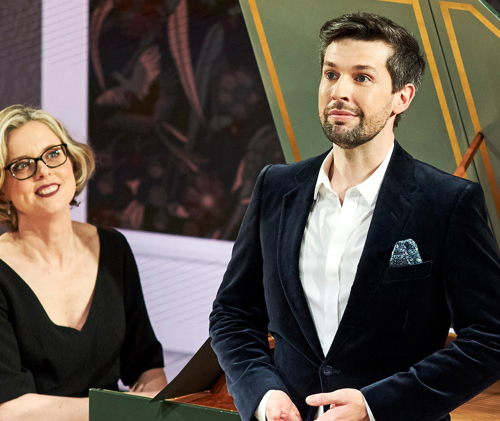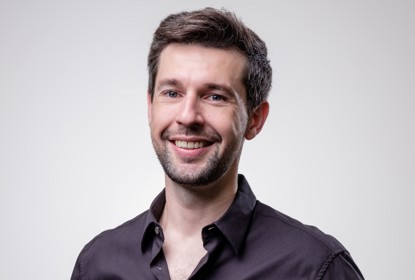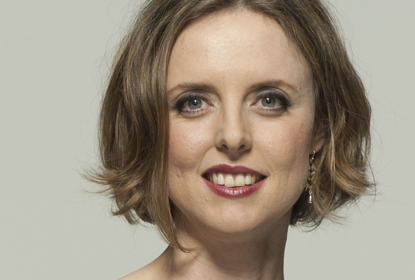From Our Stage
Countertenor Arias
Described by The Guardian UK as "an impressive Handelian, with a thrilling top register", countertenor Russell Harcourt accompanied by Heidi Jones on harpsichord/chamber organ, performs four arias by Handel, Vivaldi and Porpora.

PROGRAM NOTES
The invention of opera as an art form is closely linked with the history of the human voice and important technical developments in singing. The variety of the four characters portrayed by countertenor Russell Harcourt in this performance attest to the great range of roles and skills required of any professional opera singer, either in modern times or during the Baroque period itself.
Although the timbre and power of a castrato voice would have been very different to that of a countertenor, Russell Harcourt has an exceptional ability to sing fast passages and also to produce long, lyrical phrases fitting of the often heroic characters found in Baroque operas by Handel, Vivaldi, Porpora and others. Joined by Associate Artist Heidi Jones on the harpsichord and chamber organ, in this specially curated program Russell is first a hero (Rinaldo), then a melancholic lover (Roberto), a man reborn as a river spirit (Acis), and finally a tormented and remorseful murderer (Oreste).
George Frideric Handel (1685 – 1759)
VENTI, TURBINI FROM THE OPERA RINALDO, HWV 7
The opera Rinaldo was composed soon after Handel’s arrival in London from Germany in 1710 and marked the start of his ascendancy as one of the greatest composers for voice who ever lived. It was a sensation – brilliant and dramatic music combining with never before seen staging and special effects: “thunder and lightning, illuminations and fireworks … painted dragons spitting wildfire, enchanted chariots drawn by Flanders mares, and real cascades in artificial landscapes”. There were live sheep and oxen on stage and flights of sparrows let loose in the middle of the performance.
The bravura aria Venti, turbini written for the great castrato Nicolini showcases the extraordinary flexibility of the countertenor voice.
Venti turbini prestate
le vostre àle à questo piè.
Turbulent winds,
lend your wings to these prayers.
Antonio Vivaldi (1678 – 1741)
ESTINGUERE VORREI FROM THE OPERA GRISELDA, RV 718
Although his operas are barely known by present-day audiences, Vivaldi was one of the most successful opera composers in Italy in his own time and claimed to have written over ninety operas. His opera composing career covered almost thirty years, from 1713 to 1741, and he spent long periods travelling throughout Italy staging his own operas.
Griselda, a dramma per musica in three acts, is typical of Vivaldi's later operatic output. It was commissioned by the impresario Michele Grimani for Venice's Ascensiontide Festival 1735, and was given its first performance on 18 May at one of the city's finest theatres, the Teatro San Samuele. The opera’s plot revolves around two couples: Gualtiero and Griselda (the King of Thessaly and a poor shepherdess), and Roberto and Costanza (an Athenian Prince and Gualtiero and Griselda’s daughter, thought to have been killed as a child). Following a rebellion in Thessaly, Costanza is betrothed to Gualtiero who has been forced to divorce Griselda. Here Roberto mourns the loss of his love, believing money and power will bring Costanzo to forget even his name.
Estinguere vorrei
la fiamma ond’io sospiro
ma se quell’occhio miro
ritorno a sospirar.
… I wish I could extinguish
This burning flame inside;
But when I look into those eyes,
I yearn for her again.
Nicola Porpora (1686 – 1768)
ALTO GIOVE FROM THE OPERA POLIFEMO
By 1733 Porpora had moved to Venice and was teaching singing to the girls at a different Venetian orphanage when he was hired as music director for the Opera of the Nobility. It was set up to rival Handel’s opera company, but despite having the finest company of singers ever assembled, including Porpora’s star pupil the great castrato Farinelli, the company folded in 1737.
Polifemo premiered in London on 1 February 1735 with Farinelli, who was a sensation. The libretto was based on the classical Greek myth of the giant Polyphemus who fell in love with the water nymph Galatea, who preferred the shepherd Acis. Finding the lovers together, Polyphemus crushed his rival under a rock but Acis was transformed into a river spirit by Zeus (Giove), King of the gods.
Alto Giove è tua grazia e tuo vanto
il gran dono di vita immortale
che il tuo Cenno sovrano mi fà.
Great Jove, it is your mercy and virtue
that gives me this great gift of immortal life,
at your sovereign command.
George Frideric Handel (1685 – 1759)
AGITATO DA FIERE TEMPESTE FROM THE PASTICCIO ORESTE, HWV A11
A pasticcio (meaning ‘hash’ in Italian) was an opera consisting of arias by a number of different composers adapted to an existing libretto (text). In a period where operas were composed for specific singers, it was costly for a revival of an opera to be re-composed for new singers, so it became common practice for opera impresarios to allow singers to supply arias that they already knew and which had been composed for them. A house composer provided the only original music – the ensembles and the recitatives, sung speech which supplied the narrative and linked the arias. Because opera seria was composed according to fairly rigid conventions, it was a simple matter to slot an aria written for one opera into the libretto for another. The main drawback, apart from inconsistency in the musical standard of the arias, was the risk of a lack of musical variety or that the arias chosen by the singers would not fit the drama.
Pasticcios were regularly performed throughout Europe from the end of the seventeenth century until the end of the eighteenth and were particularly common in London. Oreste was a self-pasticcio, as Handel re-used arias from his own earlier operas. The role of Orestes was sung by the great castrato Carestini, Handel’s big drawcard for the 1733-34 season. Carestini was described by the eighteenth-century English music historian Charles Burney as “tall, beautiful and majestic … a very animated and intelligent actor” who had “the most perfect style of singing”.
This aria was originally from Handel’s opera Riccardo Primo Re d’Inghilterra (Richard I King of England). It is a ‘tempest’ aria, a device often used in opera seria to metaphorically convey a character’s emotional turmoil.
Agitato da fiere tempeste
Se il nocchiero rivede sua stella
Tutto lieto e sicuro sen va.
Tossed by fierce storms,
If the helmsman can see his star
He feels that all will be well.
Program Notes and Translations: © Lynne Murray & Alan Maddox, 2007 & 2013
Additional Program Notes and Translations: Joanna Butler & Hugh Ronzani, 2020
Image Credit: Keith Saunders, 2020
Artists
{% error.message %}
More for you...
{% series.name %}
Featured Content
{% series.featuredTitle %}












